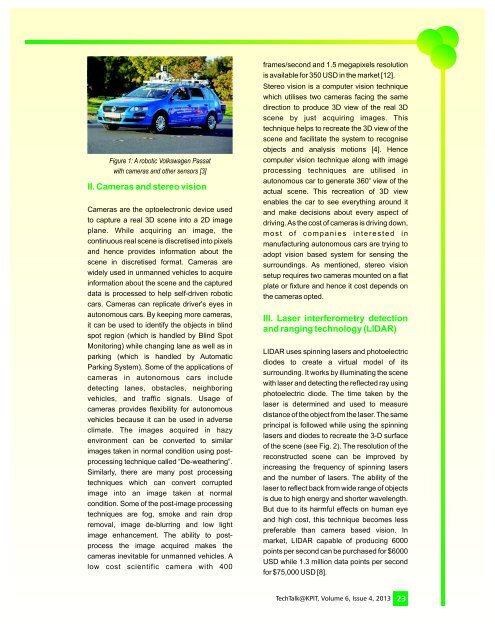Autonomous Vehicles - KPIT
Autonomous Vehicles - KPIT
Autonomous Vehicles - KPIT
You also want an ePaper? Increase the reach of your titles
YUMPU automatically turns print PDFs into web optimized ePapers that Google loves.
Figure 1: A robotic Volkswagen Passat<br />
with cameras and other sensors [3]<br />
II. Cameras and stereo vision<br />
Cameras are the optoelectronic device used<br />
to capture a real 3D scene into a 2D image<br />
plane. While acquiring an image, the<br />
continuous real scene is discretised into pixels<br />
and hence provides information about the<br />
scene in discretised format. Cameras are<br />
widely used in unmanned vehicles to acquire<br />
information about the scene and the captured<br />
data is processed to help self-driven robotic<br />
cars. Cameras can replicate driver's eyes in<br />
autonomous cars. By keeping more cameras,<br />
it can be used to identify the objects in blind<br />
spot region (which is handled by Blind Spot<br />
Monitoring) while changing lane as well as in<br />
parking (which is handled by Automatic<br />
Parking System). Some of the applications of<br />
cameras in autonomous cars include<br />
detecting lanes, obstacles, neighboring<br />
vehicles, and traffic signals. Usage of<br />
cameras provides flexibility for autonomous<br />
vehicles because it can be used in adverse<br />
climate. The images acquired in hazy<br />
environment can be converted to similar<br />
images taken in normal condition using postprocessing<br />
technique called “De-weathering”.<br />
Similarly, there are many post processing<br />
techniques which can convert corrupted<br />
image into an image taken at normal<br />
condition. Some of the post-image processing<br />
techniques are fog, smoke and rain drop<br />
removal, image de-blurring and low light<br />
image enhancement. The ability to postprocess<br />
the image acquired makes the<br />
cameras inevitable for unmanned vehicles. A<br />
low cost scientific camera with 400<br />
frames/second and 1.5 megapixels resolution<br />
is available for 350 USD in the market [12].<br />
Stereo vision is a computer vision technique<br />
which utilises two cameras facing the same<br />
direction to produce 3D view of the real 3D<br />
scene by just acquiring images. This<br />
technique helps to recreate the 3D view of the<br />
scene and facilitate the system to recognise<br />
objects and analysis motions [4]. Hence<br />
computer vision technique along with image<br />
processing techniques are utilised in<br />
o<br />
autonomous car to generate 360 view of the<br />
actual scene. This recreation of 3D view<br />
enables the car to see everything around it<br />
and make decisions about every aspect of<br />
driving. As the cost of cameras is driving down,<br />
m o s t o f c o m p a n i e s i n t e r e s t e d i n<br />
manufacturing autonomous cars are trying to<br />
adopt vision based system for sensing the<br />
surroundings. As mentioned, stereo vision<br />
setup requires two cameras mounted on a flat<br />
plate or fixture and hence it cost depends on<br />
the cameras opted.<br />
III. Laser interferometry detection<br />
and ranging technology (LIDAR)<br />
LIDAR uses spinning lasers and photoelectric<br />
diodes to create a virtual model of its<br />
surrounding. It works by illuminating the scene<br />
with laser and detecting the reflected ray using<br />
photoelectric diode. The time taken by the<br />
laser is determined and used to measure<br />
distance of the object from the laser. The same<br />
principal is followed while using the spinning<br />
lasers and diodes to recreate the 3-D surface<br />
of the scene (see Fig. 2). The resolution of the<br />
reconstructed scene can be improved by<br />
increasing the frequency of spinning lasers<br />
and the number of lasers. The ability of the<br />
laser to reflect back from wide range of objects<br />
is due to high energy and shorter wavelength.<br />
But due to its harmful effects on human eye<br />
and high cost, this technique becomes less<br />
preferable than camera based vision. In<br />
market, LIDAR capable of producing 6000<br />
points per second can be purchased for $6000<br />
USD while 1.3 million data points per second<br />
for $75,000 USD [8].<br />
TechTalk@<strong>KPIT</strong>, Volume 6, Issue 4, 2013<br />
523


